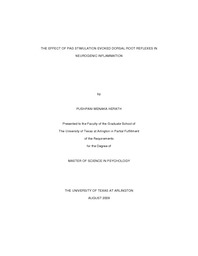
ATTENTION: The works hosted here are being migrated to a new repository that will consolidate resources, improve discoverability, and better show UTA's research impact on the global community. We will update authors as the migration progresses. Please see MavMatrix for more information.
Show simple item record
| dc.contributor.author | Herath, Pushpani Menaka | en_US |
| dc.date.accessioned | 2009-09-16T18:19:02Z | |
| dc.date.available | 2009-09-16T18:19:02Z | |
| dc.date.issued | 2009-09-16T18:19:02Z | |
| dc.date.submitted | January 2009 | en_US |
| dc.identifier.other | DISS-10298 | en_US |
| dc.identifier.uri | http://hdl.handle.net/10106/1730 | |
| dc.description.abstract | Neurogenic inflammation is defined as inflammation produced by the sensory nerves. It contributes to the cardinal signs of inflammation: rubor (redness), tumor (swelling), color (heat), and dolor (pain or itch). It suggested that neurogenic inflammation is due to dorsal root reflex (DRR) and axonal reflex, which are antidromic electrical impulses of primary afferents. However, the central regulatory mechanisms of neurogenic inflammation are still unclear. It is known that electrical stimulation of the periaqueductal gray (PAG) can induce release of GABA in the spinal cord. GABA can act on GABAA receptors on the central terminals of the primary afferents to generate DRRs. Therefore, it was hypothesized that cutaneous vasodilatation would increase from stimulation of the PAG and that the vascular response would be attenuated by applying bicuculline (GABAA receptor antagonist) to the L4-L6 dorsal root entry zones. Furthermore we predicted that the vascular response for PAG stimulation is due to activation of descending inhibition pathways rather than activation of autonomic nervous system. Seventeen adult Lewis rats were used: three animals to determine stimulation parameters; seven for the PAG stimulation group; and seven for the Bicuculline group. DRRs were recorded from L4 or L5 dorsal roots. Blood perfusion in both hind paws was measured by a Laser Doppler Imager. In the first 3 rats, fifteen images were taken as baseline measurements and continuous images were taken for 30 minutes following stimulation of PAG (5V, 10V, 15V, and 20V; 1 Hz; 1.0 ms duration) for 20 sec. The PAG stimulation group followed the same methodology using the established optimum stimulation parameters, and the Bicuculline group differed from the PAG group by applying bicuculline to the dorsal roots entry zones before electrical stimulation. The mean arterial blood flow was calculated by selecting a region of interest (ROI). Two ROIs were outlined around each hind paw, and percent change scores were calculated to normalize mean responses. A 2 (group) x 2 (side) x 3 (stimulation) mixed ANOVA followed by Fisher's LSD was used for statistical analysis. The blood perfusion on both sides significantly increased following stimulation of PAG. Increased blood perfusion following PAG stimulation was attenuated by bicuculline. The results were consistent when compared between percentage values and mean blood perfusion values. One issue was a failure to observe an increase of DRRs following stimulation of PAG. There was no change in heart rate, suggesting no involvement of autonomic nervous system. The present study concluded that the DRR plays a significant role in causing cutaneous neurogenic inflammation, and descending inhibition can influence the development of neurogenic inflammation. Furthermore, these results demonstrate a role of the central nervous system in neurogenic inflammation. | en_US |
| dc.description.sponsorship | Peng, Yuan Bo | en_US |
| dc.language.iso | EN | en_US |
| dc.publisher | Psychology | en_US |
| dc.title | The Effect Of Pag Stimulation Evoked Dorsal Root Reflexes In Neurogenic Inflammation | en_US |
| dc.type | M.S. | en_US |
| dc.contributor.committeeChair | Peng, Yuan Bo | en_US |
| dc.degree.department | Psychology | en_US |
| dc.degree.discipline | Psychology | en_US |
| dc.degree.grantor | University of Texas at Arlington | en_US |
| dc.degree.level | masters | en_US |
| dc.degree.name | M.S. | en_US |
| dc.identifier.externalLink | http://www.uta.edu/ra/real/editprofile.php?onlyview=1&pid=157 | |
| dc.identifier.externalLinkDescription | Link to Research Profiles | |
Files in this item
- Name:
- Herath_uta_2502M_10298.pdf
- Size:
- 8.832Mb
- Format:
- PDF
This item appears in the following Collection(s)
Show simple item record


